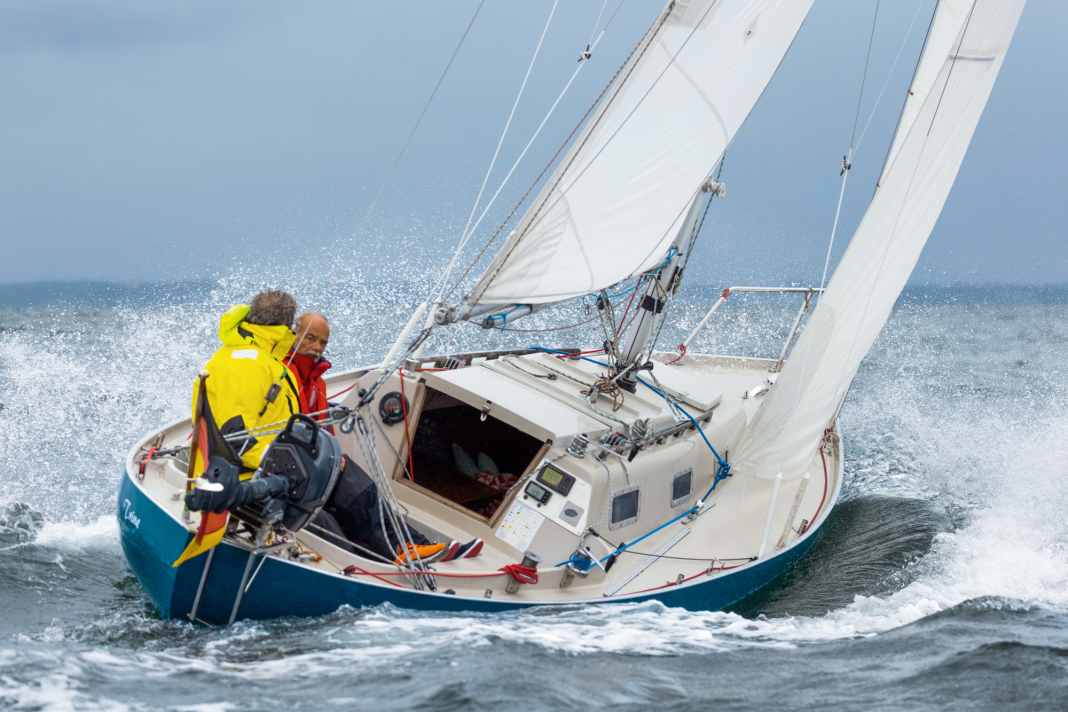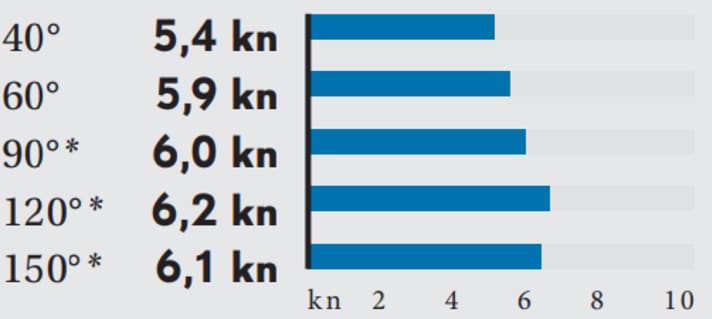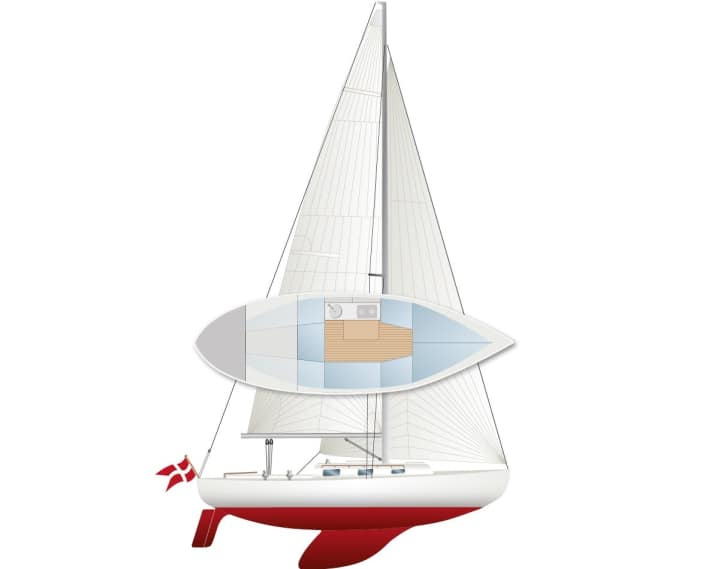Spækhugger in the used boat test: Fast pointed gate wants to get to the Spæk
Andreas Fritsch
· 27.06.2024






"Go ahead and get on the boat," said sailing mate Ecki, in case we arrive before him in Niendorf on the Baltic Sea, where his "Spæki" is moored. Some sailors affectionately call the boat that. The name sounds like bacon and has something to do with it: in Danish, a "spækhugger" is a "bacon hunter" and the name for the orca or killer whale. The Danish boat builder and yacht designer Peter Bruun was fascinated by these animals. He therefore gave his first design this name because he liked the round, smooth shapes. At the time, Bruun learnt from the Danish pointed stern legend Aage Utzon, whose boats with round sterns were very popular. Even today, many Denmark fans think of this type of wooden boat when they think of the boats of their Nordic neighbours.
Bruun, only 17 years old and an apprentice at the Walsted shipyard, built the ship as a quarter-tonner without a cabin superstructure for regattas. In the same year, he sailed in the "Seeland Rundt" regatta and sensationally achieved second place behind Paul Elvstrøm, which brought him a lot of attention. Classic lines and closeness to nature were important, but above all the boat had to be fast. The underwater hull therefore has a modern, split lateral plan with a fin keel and canoe stern. The Dane fitted a twelve-metre aluminium profile as a powerful rig with 40 square metres of sail area on top. Even with a high boat weight of 2.28 tonnes, at just over 4.8 this still corresponds to the sail carrying capacity of a performance cruiser today.
The crew sits almost dinghy-like
Can you see that on the jetty? As we stand in front of the box, we immediately notice that the ship has a very low freeboard by today's standards. The crew sits in the cockpit close to the water, almost like in a dinghy.
And the lines are really very organic, but also beautifully coherent, not as bulbous as Bruun's later, even more frequently built design, the Grinde. Light, elegant deck lines and a beefy-looking bow, which is currently back in fashion. The DNA of the keelboat is clearly evident when stepping over it: even with 87 kilograms on the side deck, the boat hardly moves when you go aft. In fact, the Spækhugger has a very high ballast ratio of 60 per cent and is considered to be very seaworthy. It has also often been used for transatlantic trips to the Caribbean. The only question is: Is it still fun 50 years later?
As if on cue, boat owner Eckart König, a dentist from Lübeck, appears. With a firm handshake and a broad smile, he stands on the jetty with fellow sailor Michael. The two tanned men look in great shape. As it turns out, they have sailed 505s very actively as a crew for many years. We want to know how he came across this particular type of boat.
"We had heard a lot about the good sailing characteristics and the very special look simply appealed to me." The other criteria were fun Wednesday regattas for him and a relaxing three-week holiday cruise in Denmark for his wife. Low purchase and maintenance costs were also important. They found what they were looking for twelve years ago in Svendborg for not quite 9,000 euros. "The boats are cheaper in Denmark than in Germany, and there's also a wider choice," says König.
Spækhugger are very popular in Denmark, the choice is large
No wonder, of the just over 400 boats that were built, many are still very actively sailed in Denmark, where the Spækhugger is a popular and active regatta class. Designated hotspots for the class are Århus and Copenhagen, where Peter Bruun also had his shipyard. In the former, more than 30 of the boats are lined up next to each other and start the regatta every Tuesday, often around 20 as a single class. The boat is particularly popular with young sailors due to its good sailing characteristics, very solid substance and low prices. And so popular that fans of the class built new moulds for the boat in 2003, production of which ended in the early 1980s. A few examples were then built before Peter Bruun took over the mould in 2006.
According to the class association, five old hulls are currently being fitted with newly built decks. The class association's commitment to its members is just as amazing: the website provides heaps of top tips for detailed improvements in comfort, fitting arrangement and dimensioning as well as repairs, also in German.
What's more, when it became clear that a new rig can easily cost 12,000 euros after a mast breakage, which in many cases far exceeds the insurance value of the boats and therefore leaves young crews in particular with a financing gap, the Danes took action. They bought the mould for producing the profile from the manufacturer and have 25 new aluminium profiles pressed every few years - at a cost price of just 5,000 kroner (around 670 euros). Although the boat is not as popular and sporty in Germany, interested parties can almost always find a few boats on the used boat market, although the family version is less common.
Spækhugger run well in almost any weather
Now it's finally time to get out on the water. Contrary to the forecast, the Baltic Sea is showing its nasty side: thick rain clouds are gathering, it is showering and blowing extremely gusty at 15 to 22 knots. Good weather for a full main and the small headsail, decides owner Ecki. Unfortunately, the beautiful, laminated black genoa has to stay in the bag. The headsail is set on staysails, only a few boats have furling systems, but almost always several headsails and a spinnaker.
The long-shaft outboard of the 25-footer is raised on a sliding rail and folded down before leaving the harbour. Almost all Spækhuggers are motorised in this way, only the Family version built from 1977 with a rounder cabin superstructure for more space below deck and a slightly modified cockpit is occasionally seen with an inboard and furling foresail.
Outside it is steel grey, clouds and water blur almost seamlessly. Rough gusts, but the waves are limited, maybe 80, 90 centimetres, short and steep of course, just like the Baltic Sea. Sails up, and the Spæki is already steaming away as if on rails, and a 6 appears quite quickly in front of the decimal point on the log. A few degrees down, the boat is already running at hull speed. Nothing unusual, the owner assures us. "It's actually a perfect five-knot cut boat, so you can plan with the Spækhugger in almost any weather," he says.
And it is super direct and balanced on the rudder, which is suspended from a small skeg and produces very little pressure. As is usual for this type of construction, the boat runs with good directional stability, but without appearing sluggish. It is also remarkable how smoothly the Spækhugger goes through, almost over the short wave. Even quite high up in the wind, it runs like a hot knife through butter, doesn't pitch, as is sometimes the case with modern sports boats of this size with a flat underwater hull, and never bores into waves.
The Spækhugger is ideal for three people
Then Michael and Ecki hoist the spinnaker. The boat is always sailed with three men in regatta mode. And the Spækhugger is already flying away, repeatedly reaching almost seven knots on the log with the help of the tiny waves.
The boat is easy to control. Drop in time in the gusts, then everything stays in the green zone. It simply provides unadulterated sailing fun. Winches and fittings are easy to reach and correctly dimensioned, the cockpit is ideal for three people to sail, but with four you would be standing on your feet a little. The narrow stern, typical of the period in which the boat was built, takes up a lot of space. The crew sits close to the surface of the water, but also quite low and well protected by a high cockpit coaming. Waves that find their way onto the foredeck are not a problem, and spray water surprisingly rarely reaches the sailors.
As popular regatta boats, Spækhuggers rarely have a sprayhood, which looks a little out of place on the narrow superstructure of the racing version. If this is important to you, you should look for the family version with a wider cabin roof, where it is fitted more frequently.
The test boat also did not have a fixed mainsheet traveller with riding beam, which many regatta-oriented owners retrofit, but instead only a rope triangle, as known from dinghies, but with tackles. All halyards and reefing lines are redirected into the cockpit via blocks at the foot of the mast, and two winches on the coachroof allow effective work on them.
Spartan interior, good sense of space
Then it's back to the harbour, with the important questions of living comfort and known weaknesses of the design still to be clarified. Although the boat is rather spartan below deck, the feeling of space is pleasantly open and bright due to the lack of bulkheads in the foredeck. Despite its small dimensions and low freeboard, the boat offers good headroom when seated, even for people just under two metres tall like the tester, but you can't lean against the edge of the superstructure. In addition: retractable cooker with mini sink on the port side, large V-berth in the foredeck and a long dog berth on the starboard aft side. The other side is barely accessible due to the galley and is ideal for storing sails or bags. There is plenty of stowage space under the berth cushions and additional shelves under the companionway and above the galley. There is enough space for two people, even for longer trips.
Many of the racing versions of the boat had a dinette, whereas the test boat has a completely open foredeck, even without the half bulkhead that was often installed before. It is typical of the Spækhugger that crews have customised it over the years. Some have chemical toilets, some none at all, some throw out the kitchen, others the shelves on the starboard side. They would have been a nuisance, but instead he has fitted cloth bags, which provide storage when needed and are nice and light when empty during regatta sailing, says the owner.
The boat has no forecastle boxes, but a locker under the aft deck where the owner stows fenders and lines. There is also no compartment for the anchor in the foredeck, which is stowed under the foredeck berth together with the chain and lead line.
It is common for many Spækhugger owners to have a cake hut as an extension to their living space in the harbour. Often rectangular in shape, with slats in the roof. "Instead, we use a simple throw tent from the outdoor sector," says owner Ecki. They have removed the inner tent, including the floor, and stretch it over the companionway and cockpit. This is lighter and cheaper.
The weak points of the Spækhugger
That leaves the question of the boat's critical points. The Achilles' heel is the deck, which has a balsa wood core. All screws that are used for fittings become potential leakage points over the years. The water can then penetrate the wood and cause it to rot. You should therefore pay close attention to soft, even yielding areas in the deck. A repair always means having to cut open parts of the deck and is associated with a lot of work and costs. Prospective buyers are advised to lightly tap the deck around the fittings. If it suddenly sounds different or muffled, this is an alarm sign. If you have any doubts, hire an expert to carry out a moisture measurement, costing around 500 euros.
You should also check the area around the mast sleeve and the collar of the inserted profile, which tends to break. There are often additional pulleys bolted to the highly stressed area of the deck, which can allow moisture to penetrate.
The tip, on the other hand, is to drill out the holes: remove the screws and drill out the holes with ten to twelve millimetre drill bits, then fill with epoxy and GRP and microballoons and finally drill through again to the required size. This protects the balsa in the future. Spækhuggers are often heavily chalked, especially as some of them were sold with coloured hulls. "But because the boats have such good substance and are very old, they are polished through at some point after decades. We also had places where we had reached the clutch," says owner Ecki. They then had the hull painted above water, which cost 2,500 euros in 2019. Later, when they had to remove the old underwater paintwork, an epoxy barrier coat was also applied to prevent osmosis. However, the boats are not susceptible to this. However, the steel keel tends to rust. They therefore also had it derusted and coated with epoxy, and it has been quiet ever since.
Overall: For purist crews with a small budget, the Speckjäger itself is a good catch. The costs are low and the boat is indestructible. With the guidance of the Danish class association, the boat with its unusual appearance can be ideally pimped into a smart daysailer.
Model history
The original race version was built by Flipper Scow in Denmark from 1970 until the early 1980s. The family version was added in 1977. 2003 new mould construction for the racing version, since then several new builds. Enquiry via Peter Bruun (www.peterbruun.dk)
The measured values for testing the Spækhugger
Sailing performance

without drift/current; wind speed: 15 to 21 kn (4-5 Bft), wave height: approx. 0.8 m * with spi
Potential STZ1 = 4.81

In keeping with its regatta roots, the sail carrying capacity is in the range of modern cruiser-racers
The Spækhugger in detail

Technical data of the Spækhugger
- Designer: Peter Bruun
- Torso length: 7,44 m
- Waterline length: 6,30 m
- Width: 2,33 m
- Depth: 1,45 m
- Mast height above WL: 12,00 m
- Theoretical torso speed: 6.0 kn
- Weight: 2,280 t
- Ballast/proportion: 1,37 t/60 %
- Mainsail: 18 m²
- Genoa (106 %): 21 m²
- Fock: 17 m²
- Spi: 60 m²
- Motor: Outboard motor, approx. 5-7 hp
- Yardstick value: 109
- Built since: 1970
- Quantity: 415
The Spækhugger as a second-hand boat
Market situation
There are almost always a few boats on the market, many in Denmark too, but more often the race version, touring versions are rarer. Prices for boats in need of refit are around 5,000 to 8,000 euros. Boats that have already been extensively refitted and painted cost around twice as much, depending on the quality of the work
Prices
- Most recently in 2009 for self-rigging without sails, running rigging and fittings: 34.000 €
- Price used: 5,000 to 16,000 €
YACHT review of the Spækhugger
Beautifully shaped, very stable and fast pointed galley that is great fun to sail. The boat is also suitable for two people as a touring boat
Design and concept
- + Good performance
- + Timeless, pleasing design
- + Very solid GRP construction quality
- - Balsa core sensitive to moisture on fittings
Sailing performance and trim
- + Light wind power
- + Sophisticated fittings and trimming devices
- - Furling headsails must be furled with four sheets
Living and finishing quality
- + Good, bright feeling of space
- + Very long bunks
- - Sprayhood rare and difficult to retrofit
Equipment and technology
- + Simple, functional technology that is easily accessible everywhere, no interior panelling or similar.
- + A huge number of good instructions on the Danish class for modernising or completely refitting the boat
The Spækhugger in video
If the Spækhugger is too small for you, you might like the boat's big brother, the Grinde, which was developed later. It offers more space and comfort and similarly good sailing characteristics. The YACHT used boat test in the video:

